The
Author - Robert L. May
CLICK
FOR MAIN XMAS PAGE
Beginnings
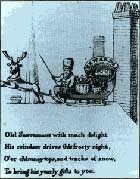
1821
A small, sixteen-page booklet appeared, titled A New Year’s Present
for the Little Ones from Five to Twelve, Part III. It was about Christmas,
and was the first to picture Santa Claus in a sleigh drawn by a reindeer.
1823
Reindeer names invented by Clement Clarke Moore. TRIVIA NOTE: In the
poem "A Visit from St. Nicholas" (1823) written by Clement
Moore, Santa Claus only had eight reindeers: Dasher, Dancer, Prancer,
Vixen, Comet, Cupid, Donner, and Blitzen
1902?
Robert L. May born. Bob May knew only too well what it meant to be ‘‘ different. ’’ As
a child he had been weak and delicate. With the innocent cruelty of children,
his playmates had continually goaded the stunted, skinny lad to tears.
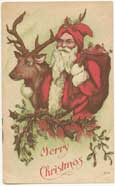
1909 Christmas card with Santa and a reindeer.
1926
Robert L. May graduates Phi Beta Kappa from Dartmouth College. May was
so small that he was always being mistaken for someone’s ‘‘ little
brother. ’’ His adult life much happier. Unlike many of his
classmates who floated from college into plush jobs, Bob became a lowly
copy writer for a New York department store.
1929
Great financial depression begins throughout America.
1935
Robert L. May joins the Chicago-based Montgomery Ward Company (operators
of a chain of department stores 1872-2001) as
an advertising writer for
the stores promo pieces. MWC Started as a mailorder house in 1872, delivering
goods to America's farmers and country people by train.. The Montgomery
Ward stores had already been buying and giving away coloring books for
Christmas every year to children as a promotional piece. Now, at 33,
May was deep in debt, depressed and miserable.
Bob May lived in a shabby two- room apartment. On a couch lay his young
wife, Evelyn, racked with cancer. For two years she had been bedridden;
for two years, all Bob’s small income and smaller savings had gone
to pay for treatments and medicines. The prospect of his wife's impending
death, life with her in a rundown apartment, and huge debts left May,
like his alter ego, Rudolph, wallowing in self-pity. May realized, the
happiness of his growing 4 year old daughter, Barbara, was also in jeopardy.
To comfort his daughter he would tell her stories. He made up one about
a red-nose reindeer which his daughter would have him repeat over and
over. He eventually wrote it down and added crude pictures and gave it
to Barbara for Christmas.
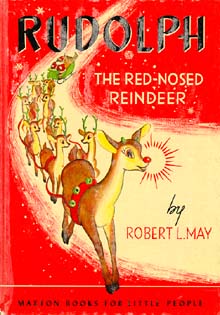
33 pages
Publisher: Scholastic
ISBN: 0439445221
Paperback version ebay value: ~ $200.00 - $2,700.00mint! 122505
1939
May's department head saw creating a giveaway booklet of their own as
a way to save money. May,
who had a penchant for writing children's stories and limericks, was
tapped to create a booklet.
In January 1939 May started to work. Rudolph,
the ninth reindeer, with a red and shiny nose.
May, drawing in part on the tale of The Ugly Duckling and his own background
(he was a often taunted as a child for being shy, small, and slight),
settled on the idea of an underdog ostracized by the reindeer community
because of his physical abnormality: a glowing red nose.
Looking for an alternative name, May considered and rejected Rollo (too
cheerful and carefree a name for the story of a misfit) and Reginald
(too British) before deciding on Rudolph. He then proceeded to write
Rudolph's story in verse, as a series of rhyming couplets, testing it
out on his 4-year-old daughter Barbara as he went along.
Although Barbara was thrilled with Rudolph's story, May's boss was worried
that a story featuring a red nose — an image associated with drinking
and drunkards — was unsuitable for a Christmas tale.
May responded by taking Denver Gillen, a friend from Montgomery Ward's
art department, to the Lincoln Park Zoo to sketch some deer. Gillen's
illustrations of a red-nosed reindeer overcame the hesitancy of May's
bosses, and the Rudolph story was approved by late
August.
Though the text, which gives a nod to Clement
C. Moore's famous Night Before Christmas poem. The writing is somewhat
forced, the book gets a boost from David Wenzel's illustrations of a
warm, appealing Santa. But it is May's original creativite writing and
fanciful tale that is the genius of the legend.
Evelyn May dies.
Montgomery Ward distributed 2.4 million copies of the Rudolph booket
in 1939, and although wartime paper shortages curtailed printing for
the next several years, a total of 6 million copies had been given by
the end of 1946 for Christmas.
Meanwhile,
May won acclaim-- but little else. Montgomery Ward owned the copyright.
Yet May was happy in the knowledge that his child-- and millions of other
children-- loved his red- nosed reindeer.
Donner should be Donder! Info
1941
World War II starts and the giveaway project was shelved. Throughout
the war years, however, requests poured in for Rudolph books, toys, games,
puzzles, records-- all nonexistent. And the demand mounted each Christmas
season as parents got out the old Rudolph book and read it to growing
families of new Rudolph enthusiasts.
Bob married Virginia Newton, a secretary at Montgomery Ward’s.
Together they created three new Rudolph fans-- Joanna, Christopher and
Ginger.
|1944
Rudolph hit the big screen in 1944. Max
Fleischer, in a rare commercial credit following the closure of his
studio, produced an animated version of the Rudolph story for The Jam
Handy Organization (a Detroit studio that isn't as well known as the
ones in Hollywood). That cartoon was shown endlessly on TV during the
1950s and early '60s. Unlike most Rudolph products, it's fallen out of
copyright, and is now available on many inexpensive videotapes of public
domain Christmas shorts. http://www.toonopedia.com/rudolph.htm
MAX
FLEISCHER STUDIO
Primary Product: Theatrical Animation
Producing From: 1919-42
Before Hanna-Barbera, before Warner Bros., even before Disney, there
was Max Fleischer.
Noted For: Betty Boop, Koko the Clown, Popeye animation, Superman animation,
Gulliver's Travels, and more. Produced the first sound cartoon. Another
Fleischer innovation — the bouncing ball that helped lead audiences
in sing-alongs.
1946
The war over. Touched by the beauty and simplicity of the Rudolph story,
Sewell Avery, president of Ward’s., orders the copyright turned
over to Bob-- so that May could receive all royalties. 3,600,000 Rudolph
booklets had been distributed by Ward’s. Promptly a deluge of demands
for Rudolph products swamped Ward’s and Bob May. Businessmen wired,
telephoned and called, seeking permission to manufacture toys, puzzles,
slippers, skirts, jewelry and lamps.
1947
Some
6,000,000 copies of the booklet had been given away or sold-- making
Rudolph one of the most widely distributed books in the world. A special
recording of the poem was made by Victor. Maxton Publishers, Inc., bought
the rights to produce a bookstore edition and
sold over 100,000 in two years.
Parker Brothers brought out a Rudolph game. Even Ringling Brothers- Barnum
and Bailey circus proudly exhibited a pony, equipped with antlers and
an electrically lighted red nose, called ‘‘ Rudolph the Reindeer. ’’
1947
With the rights to his creation in hand, May's financial security was
assured. "Rudolph the Red-Nosed Reindeer" was printed commercially
in 1947 and shown in theaters as a nine-minute cartoon the following
year.
1948
Sellouts all over the country inspired merchants to make even more elaborate
plans for Christmas, 1948. A special feature is the cartoon in Technicolor
directed by Max Fleischer and narrated by Paul Wing which is being run
this Christmas season in thousands of film houses. Manufacturers are
already blueprinting Rudolph merchandise for 1949- 1950- 1951-- with
each item sold returning a royalty to Bob May.
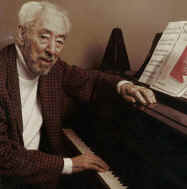
1949
The Rudolph phenomenon really took off, however, when May's brother-in-law,
songwriter Johnny Marks (1909-1985) born in Mt. Vernon, NY, developed
the lyrics and melody for a Rudolph song. Marks' musical version of "Rudolph
the Red-Nosed Reindeer" (turned down by many who didn't want to
meddle with the established Santa legend) was recorded by Gene Autry
in 1949, sold 2,000,000 copies that year, it rose to #1 on the Hit Parade
and went on to become one of the best-selling songs of all time (second
only to 1942's "White Christmas"). After attending Columbia
University, he studied music in Paris, returning stateside to work as
a radio producer; during World War II, Marks additionally produced entertainment
for American troops stationed overseas. Sold over 30 million copies in
the decades to follow, inspiring a beloved television special which premiered
in 1964. Marks was named to the Songwriters Hall of Fame, he died September
3, 1985.
Johnny Marks
In
Greenwich Village in the City of NewYork, Bob May had a brother-in-law
who wrote songs. His name was Johnny Marks. Young John had been pretty
hopeless himself as a kid. His piano teacher had given up on him. But
he grew up to be a songwriter anyway, and in 1946, when brother-in-law
Bob sent him Rudolph the Red-Nosed Reindeer, he had a notebook full of
other ideas and was only passingly interested. And so Rudolph sat on
the shelf, forgotten. Until one hot summer's day in
1949, when Johnny Marks was strolling through the city, thinking about
writing a Christmas thing, and from out of nowhere a Rudolph song came
to him, unbidden and fully wrought.
All
excited, he recorded "Rudolph the Red-Nosed Reindeer" and
sent copies
to Dinah Shore, Bing Crosby, Perry Como and other famous folks. As an
afterthought, he dropped one to Gene Autry, the singing cowboy, who was
shopping around for a new Christmas ditty to top his 1947 hit "Here
Comes
Santa Claus." Gene Autry thought "Rudolph" was about the
dopiest song he'd
ever heard and refused even to consider it. His wife, though, loved the
little tune, and so, she insisted, would every kid on Earth. Purely to
please her, Autry reluctantly stuck "Rudolph" on the B side
of "If It
Doesn't Snow on Christmas," which he was sure was going to be his
next big
hit. The throwaway was recorded in a single take, tossed into the last
10
minutes of the recording session. "If It Doesn't Snow On Christmas"
bombed. As for "Rudolph"...
In
September, Gene Autry and his famous chestnut stallion "Champion"
galloped into Madison Square Garden along with 200 Cowboys and Indians
for
the annual rodeo. Amid the barrel races and the broncos and the
war-dancing painted braves, Autry sang "Rudolph the Red-Nosed Reindeer"
from Champion's back. The instant smash sold more than 2 million records
in its first year, and sales never stopped. "Rudolph" is one
of the
greatest hits in the music business, a close second only to Bing Crosby's
"White Christmas" as the all-time top-selling single. At least
500 other
versions of the song have been made, in practically every language and
conceivable style, from Lena Horne to 'Alvin and the Chipmunks' to John
Denver, and altogether they have sold at least 150 million copies.
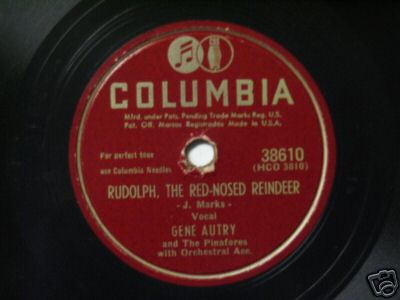 |
78 RPM 10" RECORD TITLED: ARTIST: GENE AUTRY LABEL: COLUMBIA 38610 SIDE A: RUDOLPH THE RED NOSE REINDEER SIDE B: IF IT DOESN'T SNOW ON CHRISTMAS |
|
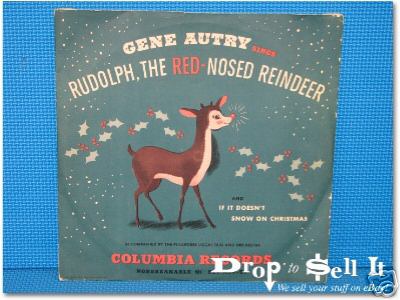 |
Gene Autry Sings Rudolph The Red-Nosed Reindeer Record |
Marks was an amazingly prolific contemporary writer of Christmas carols,
whose impact was enhanced due to the annual performance of many of
his songs on animated Christmas specials (which also included non-Christmas
songs). His Christmas songs include:
Song
/ Year
Rudolph
the Red-Nosed Reindeer, 1949
When Santa Gets Your Letter, 1950
The Night Before Christmas Song, 1952
(There’s Nothing Like) An Old Fashioned Christmas, 1952
I Heard the Bells on Christmas Day, 1956
A Merry, Merry Christmas To You, 1958
Rockin’ Around the Christmas Tree, 1958
Silver and Gold, 1964
A Holly, Jolly Christmas, 1964 sung by later by Burl Ives
Jingle, Jingle, Jingle, 1964
The Most Wonderful Day of the Year, 1964
We Are Santa’s Elves, 1964
A Caroling We Go, 1966
Joyous Christmas, 1969
Rudolph the Red-Nosed Reindeer Song
Text:
Robert L. May (1939), Johnny Marks (1949)
Melody: Johnny Marks, 1949
Music
Midi 01 Music
Midi 02
You know Dasher and Dancer
and Prancer and Vixen,
Comet and Cupid and
Donner* and Blitzen,
but do you recall
the most famous reindeer of all?
Rudolph,
the red-nosed reindeer
had a very shiny nose.
And if you ever saw it,
you would even say it glows.
All
of the other reindeer
used to laugh and call him names.
They never let poor Rudolph
join in any reindeer games.
Then
one foggy Christmas Eve
Santa came to say:
“Rudolph with your nose so bright,
won't you guide my sleigh tonight?”
Then
how the reindeer loved him
as they shouted out with glee:
“Rudolph the red-nosed reindeer,
you'll go down in history!"
Spanish Version:
Rodolfo el Reno de la Nariz Roja
Hoy quisiera contarles la historia de un reno
al que nadie quería por ser tan feo
ni siquiera el mismo imaginó
lo que un día le pasó
Era Rodolfo un reno, que tenia la nariz
roja como la grana y de un brillo singular
todos sus compañeros se reían sin parar
y nuestro buen amigo, no paraba de llorar
Pero Navidad llegó, Santa Claus bajó
y a Rodolfo eligió, por su singular nariz
tirando del trineo, fue Rodolfo sensación
y desde aquel momento toda burla se acabó
Rodolfo de reno Rodolfo
Rodolfo de reno Rodolfo
Era Rodolfo un reno, que tenia la nariz
roja como la grana y de un brillo singular
todos sus compañeros se reían sin parar
y nuestro buen amigo, no paraba de llorar
Pero Navidad llegó, Santa Claus bajó
y a Rodolfo eligió, por su singular nariz
tirando del trineo, fue Rodolfo sensación
y desde a quel momento toda burla se acabó
Rodolfo de reno Rodolfo
Rodolfo de reno Rodolfo
Pero Navidad llegó, Santa Claus bajó
y a Rodolfo eligió, por su singular nariz
tirando del trineo, fue Rodolfo sensación
y desde a quel momento toda burla se acabó
The story and song have now been translated into over 25 languages.
See
German song version
Gene
Autry lived to be 91 but never had another song that sold more than
the 15 million copies of his "Rudolph." Johnny Marks left about
900 other
songs behind him when he died in 1985, not one of them nearly so big
as
"Rudolph." Robert May wrote a few other children's books before
he died in
1976, none successful. Most of his life, he mused, had, in fact, been
spent "working for a reindeer." This didn't seem to bother
any of them
much, because Rudolph made them all quite wealthy and, as the song goes
... "they all went down in history."
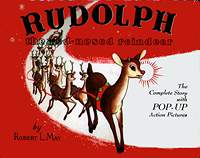
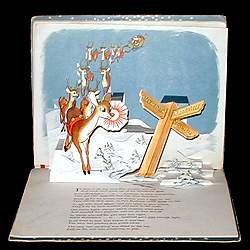
Size: 21 x 27 cm / 11 double pages
1950 Maxton Publishers Inc., NY
Spring House
ISBN: none
illustrations and pop-ups by Marion Guild.
http://www.popupbooks.net
Value is about $35 - $50 on ebay 122505
1950
The complete, original story of Rudolph in double line verse with attractive
multi-color illustrations. Five double-page fanfold pop-up scenes. Landscape
orientation, paper cover, red comb binding.
Next came the comic book, which recounted Rudolph's subsequent adventures,
after he'd become a part of Santa Claus's team. DC Comics published a
new issue each December from 1950-62. Most were drawn by Rube Grossman
(Peter Panda, Three Mouseketeers). The DC version was briefly revived
in 1972 as a tabloid, written and drawn by Sheldon Mayer (Sugar & Spike,
The Red Tornado). While the DC version was running, Little Golden Books
produced its own version of the story, and followed it with Rudolph the
Red-Nosed Reindeer Shines Again.
1951
May left Wards to manage Rudolph’s career.
1951
Original story on 78rpm records put out by RCA
Rudolph became the first significant new holiday character since Santa
Claus and his elves. Rudolph’s fame sparked the trend for the creation
of other holiday characters, such as Frosty the Snowman and the Grinch.
Rudolph is a cute and loveable character. People like him because he
was the ‘under-reindeer’—the lowest on the pecking
order. But he overcame that to become a superhero of Christmas.
Rudolph the Red-Nosed Reindeer really got the conspicuous consumption
of Christmas merchandise going. It was the first great novelty song after
World War II—people were ready for something new. The song came
out during a time of new prosperity—people had money to spend.
And this trend has continued with the introduction and merchandising
of other Christmas characters.
1958
May donated the original manuscript to the Baker Library at Dartmouth
College, which now houses the Robert L. May Collection.
1958
Returned to the company. Bob is still a shy, thin, affable man who wants
more than anything else to build security for himself and his family.
He works at Ward’s-- as retail copy chief-- and tackles the job
with the same perseverance which has characterized his whole life.
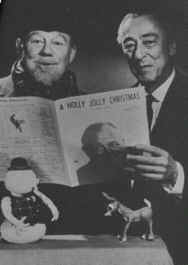
1964 (Dec. 6)
A TV special about Rudolph narrated by Burl Ives was produced and remains
a popular perennial holiday favorite in the USA. Soundtrack written by
Johnny Marks. Although that show has since become a holiday television
tradition, Rudolph's subsequent specials, Rudolph’s Shiny New Year
and Rudolph and Frosty, haven’t been nearly as popular.
Rankin/Bass
Productions (Thundercats, Silverhawks) did the best-known animated
version, the one narrated by Burl Ives as Sam the Snowman, which debuted
on NBC December 6, 1964. Rather than traditional cel animation, they
used a stop-motion technique with puppets, which they promoted under
the name "Animagic". Rudolph's voice was done by Billie Mae
Richards (Tender Heart Bear). http://www.toonopedia.com/rudolph.htm
• Movie is now out on DVD (2004)
RUDOLPH is the longest running, highest rated television special of all
time!
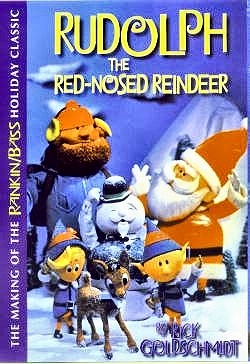
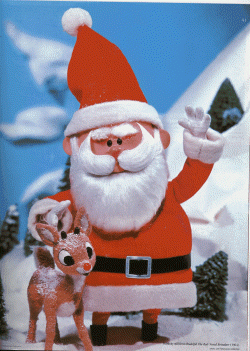
Here is the story of Rudolph The Red-Nosed Reindeer - who made it and
how they did it. Interviews with the people who wrote, directed, voiced,
and animated the show combine with a treasure trove of behind-the-scenes
photos - many never before published - to afford an in-depth look at
the creative process of this landmark TV special. 216 Pages! Foreword
by Arthur Rankin! Contains the original 1963 draft screenplay by Romeo
Muller! Buy
book
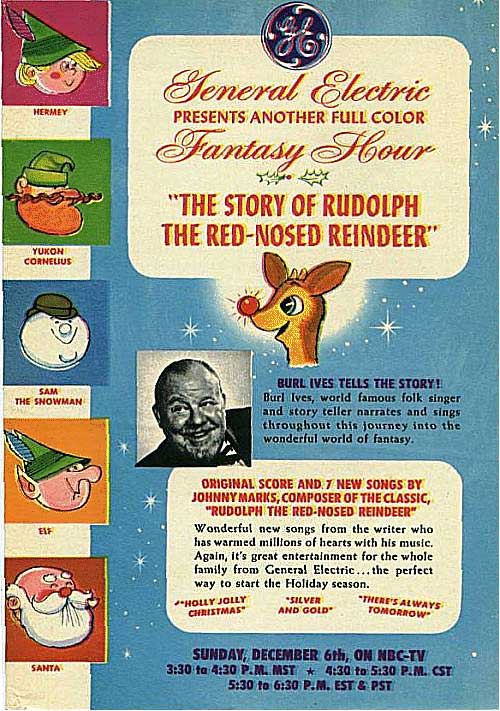
Other links:
http://www.tvparty.com/xmasrudolph.html

1967
Release of another edition of Rudolph the Red-Nosed Reindeer.
Value is about $35 - $50 on ebay 122505
1971
May retires.
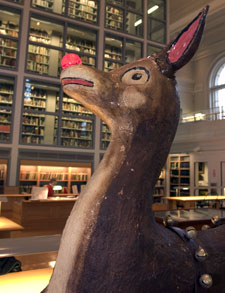 |
The sculpture was built at about the same time the story was written, 1939, and Dartmouth unveiled Rudolph as part of its collection in 1982. In addition to the sculpture, Dartmouth Special Collections also holds the original story manuscript by May and the original layout of the booklet. |
|
1976
Robert May dies. A humble, soft-spoken man, he was gratified that children
had so responded to his little story. May referred to Rudolph as ‘my
generous son,’ claiming that the reindeer enabled him to send
his six children to college.
Rudolph has been celebrated in song, story and television. His image
is displayed on clothing, jewelry, dishware, toys and more. And, until
his death in 1976 at age 71, Robert May's love affair with his reindeer
was celebrated every Christmas season with a lighted 9-foot model of
Rudolph in the front yard of his home in Evanston, Ill. just north of
Chicago.
City of Evanston,
Illinois Website
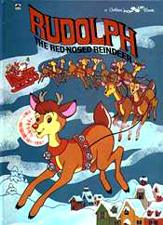
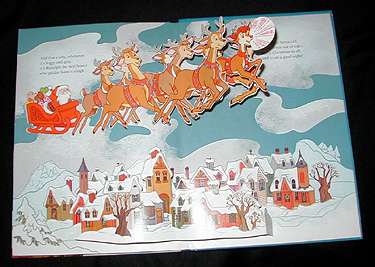
Western Publishing Company, WI
ISBN: 0307151042
Size: 20 x 27 cm / 6 double pages
Value is about $50- $75 on ebay 122505
1983
Release of another edition of Rudolph the Red-Nosed Reindeer.
This delightful Christmas story comes alive in 3-D animation! The bright
illustrations are enhanced with three double-page pop-ups, a rotating
wheel, a slat-picture, and tab-mechanicals. A Golden Pop-Up Book.
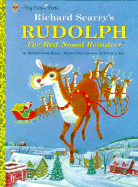
1986
Rudolph the Red-Nosed Reindeer
by Robert L. May Golden Books Richard Scarry
Binding: Hardcover Publisher: Golden Books Date Published: 1986 ISBN:
0307102033
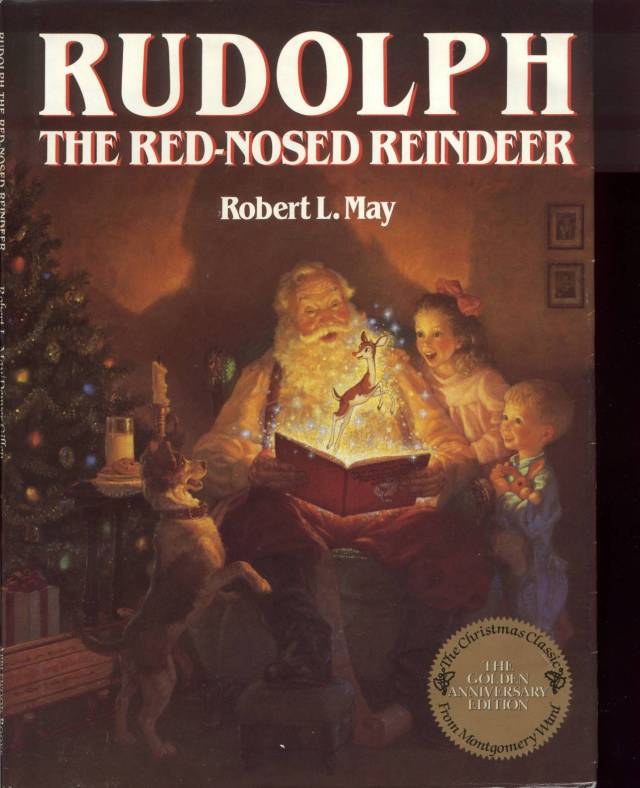
Value is about $35 - $50 on ebay 122505
1989
Wards reissued a Golden Anniversary Edition, a facsimile of the original
1939 edition, published by Applewood Books (see above).
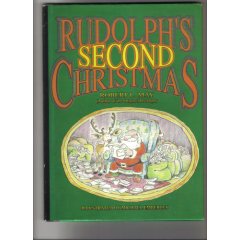
1991
Binding: Hard Cover Publisher: Applewood Books, Bedford, Massachusetts,
U.S.A. Date Published: 1992 ISBN: 1557091927
In 1991, May's daughter was working in the family attic and found several
drafts of a sequel written in 1947. These were edited into this story
and published in 1992. New illustrations were developed by Michael Emberley
to bring the story humorously up-to-date. Robert May wrote two furture
Rudolph stories that chronicle his adventures and character development.
This story, Rudolph's Second Christmas, proves every bit as enjoyable
as the other two Rudolph stories, and shows Rudolph in a more active
and charitable position.
This season the bright-nosed buck is being used by a Ward competitor,
Sears, Roebuck & Co. It was licensed to Sears by Robert L. May Co.,
which is run by the Ward copywriter's daughter.
No picture of book : (
1993
Rudolph's Adventure
by Quattrocki, Carolyn, And May, Robert Lewis, And
Binding: Hardcover Publisher: Ashley Books Date Published: 1993 ISBN:
1561737119
1998 (Oct. 16)
Rudolph the Red-Nosed Reindeer: The Movie. Rudolph's first feature-length
movie was released to video October 16, 1998. It boasted a multi-star
cast, with voices by face actors such as Whoopi Goldberg, Bob Newhart
and, as Santa himself, John Goodman. Rudolph was voice specialist Kathleen
Barr (Dot Matrix in Reboot, various voices in Sonic the Hedgehog and
Ranma ½). Barr played Rudolph again in Rudolph the Red-Nosed Reindeer & the
Island of Misfit Toys, released to video October 30, 2001. http://www.toonopedia.com/rudolph.htm Movie
Info 01
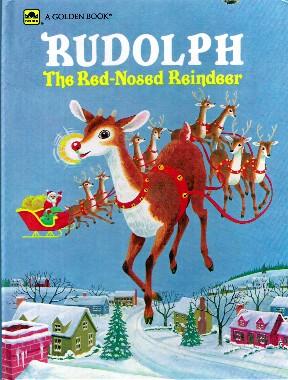
1999
ISBN: 030710849X
Publisher: Golden Books
Date published: 1999-01-01
Format: Hardcover
Author: Walt Disney Productions Disney Studios Golden Books
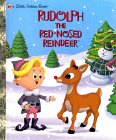
2000 ( Aug. 1)
Release of another edition of Rudolph the Red-Nosed Reindeer.
2001
Montgomery Ward went out of business in early 2001.
The bankruptcy and closing of Montgomery Ward after 128 years in business
removes another icon from the American scene - and evokes memories of
the day when it was not yet a retailing dinosaur but quite the opposite,
a path-breaking enterprise far ahead of its rivals. In a sense, Montgomery
Ward was a version of an e-commerce emporium in an era when everything
went by mail. Between 1872 and 1926, it owned no stores, operating strictly
on a mail-order -- not even phone-order -- basis in a time when mail
order still felt breathtakingly swift and somehow adventuresome.
See article 01
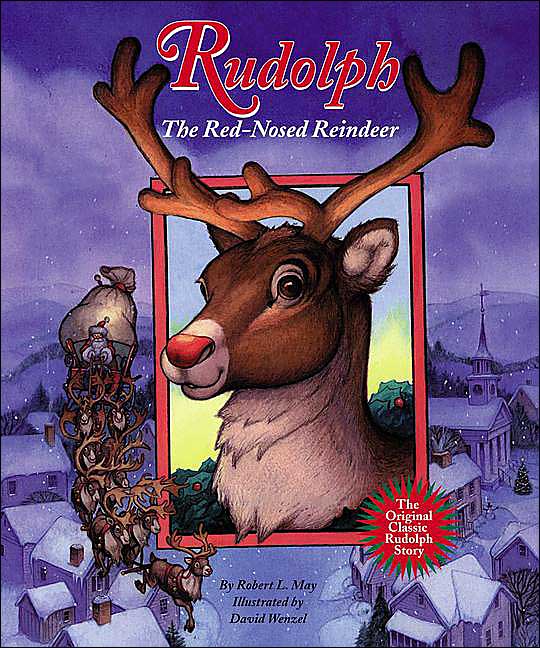
ISBN: 0448425343
Publisher: Grosset & Dunlap
Hardcover
40pgs
2001 (Sept.)
Release of another edition of Rudolph the Red-Nosed Reindeer.
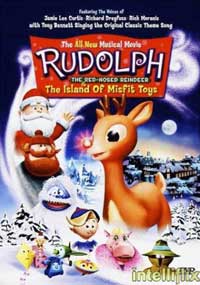
2001-10-30
Rudolph the Red-Nosed Reindeer & the Island of Misfit Toys. UPC:
018713812360 Length: 80 min.
Movie released to video October 30, 2001. http://www.toonopedia.com/rudolph.htm
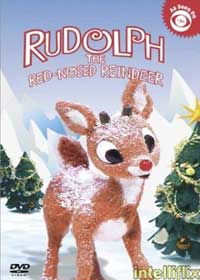
2002-09-24
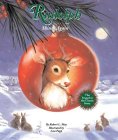
2003-09-22
Rudolph Shines Again
by May, Robert L, and Papp, Lisa (Illustrator)
Binding: Hardcover Publisher: Grosset & Dunlap Date Published: 09/2003
ISBN: 044843198X
Release of Rudolph Shines on.
This sequel to the beloved classic tells how, once again, Santa needs
the red-nosed reindeer to lead his sleigh. However, mean teasing from
the other reindeer causes Rudolph to lose his light. Full color.
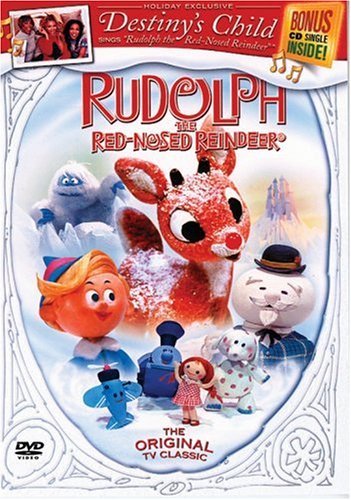
2004 (Sept. 14)
Rudolph DVD of 1964 original movie
ASIN: B0002I82XW
Aspect Ratio: 1.33:1
Studio: Sony Wonder (Video)
The DVD version seems to be cleaned up from the 1964
TV version in terms of quality. With a run-time of 65 minutes, this
DVD has hardly any extras. There's a lost scene which originally aired
in place of the song "Why Am I Such A Misfit?" (an optimistic
tune about striking out and finding your fortune). You can also view
the DVD in Spanish, and my son gets a kick out of doing that once in
awhile.
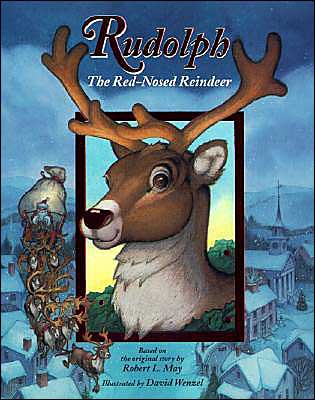
2004 (Sept. 22) 22pgs.
Release of another edition of Rudolph the Red-Nosed Reindeer.
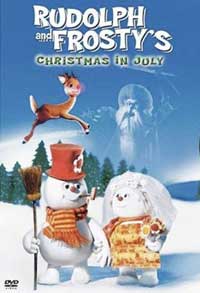
2004-10-05
Rudolph and Frosty's Christmas in July DVD. UPC: 012569420120 Length:
97 min.
When the evil Winterbolt learns the secret to Rudolph the Red-Nosed Reindeer's
nose
Who owns Rudolph Now?
Rudolph is managed by Classic Media, Inc.: Classic
Media
Rudolph is owned by the Robert L. May Company, - now called "The
Rudolph Company, L. P. of 901 Railroad Avenue, Novato, California 94945,
USA ", which, according to a message board post elsewhere, consists
of author RLM's six children.
© 2001 The Rudolph Company, L.P. Rudolph the Red-Nosed Reindeer® Reg.
U.S. Pat. & TM Off. The Rudolph Company, L.P. under license to GT
Merchandising & Licensing Corp.
It might be fitting to close this page by pointing out that, although the story of Rudolph is primarily known to us through the lyrics of Johnny Marks' song, the story May wrote is substantially different in a number of ways.
Rudolph was not one of Santa's reindeer (or the offspring of one of Santa's reindeer), and he did not live at the North Pole. Rudolph dwelled in an "ordinary" reindeer village elsewhere, and although he was taunted and laughed at for having a shiny red nose, he was not regarded by his parents as a shameful embarrassment.
Rudolph was brought up in a loving household and was a responsible reindeer with a good self-image and sense of worth. Moreover, Rudolph did not rise to fame when Santa picked him out from the reindeer herd because of his shiny nose. Santa discovered the red-nosed reindeer quite by accident, when he noticed the glow emanating from Rudolph's room while delivering presents to Rudolph's house.
Worried that the thickening fog — already the cause of several accidents and delays — would keep him from completing his Christmas Eve rounds, Santa tapped Rudolph to lead his team, observing upon their return: "By YOU last night's journey was actually bossed. Without you, I'm certain we'd all have been lost!"
Sources:
Archibald, John J. "Rudolph's Tale Left Him Cold."
St. Louis Post-Dispatch. 6 December 1989 (p. E3).
Flynn, Tom. The Trouble with Christmas.
Buffalo, NY: Prometheus Books, 1993. ISBN 0-87975-848-1 (pp. 122-123).
Frankel, Stanley A. "The Story Behind Rudolph the Red-Nosed Reindeer."
Good Housekeeping. December 1989 (p. 126).
Lillard, Margaret. "Rudolph Lit Up Creator's Career."
Los Angeles Times. 17 December 1989 (p. A7).
Morrison, Gary W. "How an Advertising Copywriter Helped Rudolph Become 'The Most Famous Reindeer of All.'"
The Grand Rapids Press. 15 December 1998 (p. C1).
Lollar, Kevin. "Reginald the Red-Nosed Reindeer?"
Gannett News Service. 21 December 1989.
Murphy, Cullen. "Rudolph Redux."
The Atlantic. August 1990 (p. 18).
Ogintz, Eileen. "The Man Who Created Rudolph . . ."
Chicago Tribune. 13 December 1990 (Tempo; p. 1).
The Palm Beach Post. "Rudolph's Rise to Fame Was Long, Arduous"
25 December 1999 (p. A21).
The Time-Life Book of Christmas.
New York: Prentice Hall, 1987. ISBN 0-13-133679-7 (p. 101).
http://www.snopes.com/holidays/christmas/christmas.asp
Links
CLICK FOR MAIN XMAS PAGE
http://www.dailykos.com/story/2005/12/7/102735/045
http://www.novareinna.com/festive/deer.html
Hint: Type in "rudolph reindeer" in ebay to see Rudolph items for sale.
Friday, November 28, 2008 9:56 PM